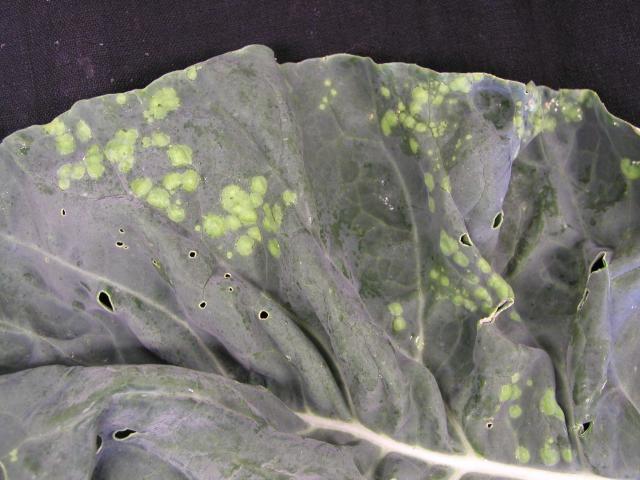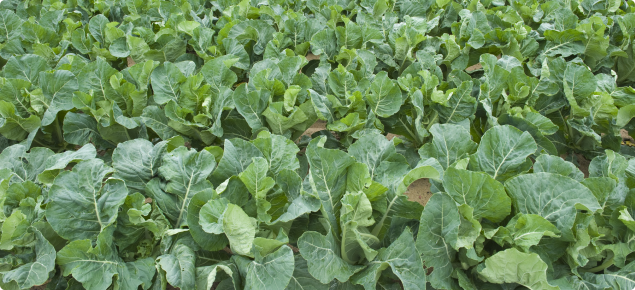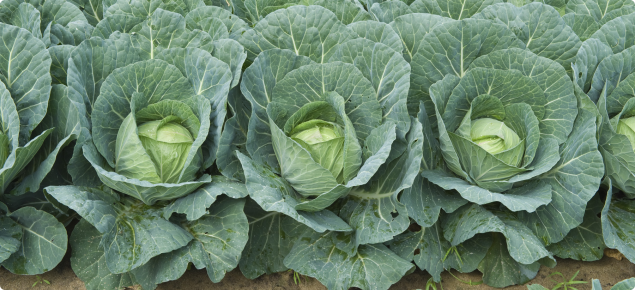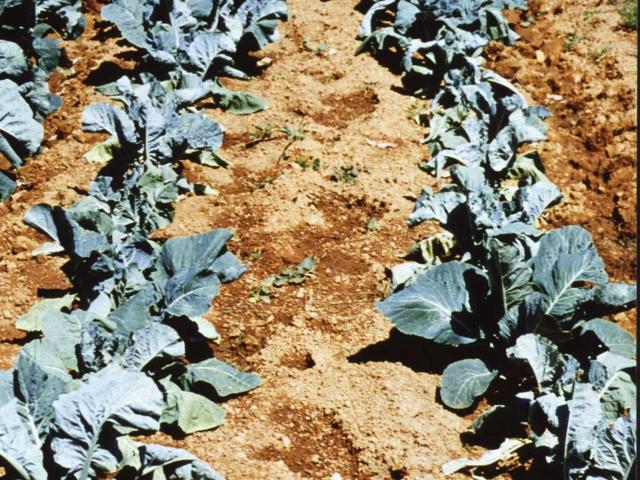Bacterial diseases
Black rot (Xanthomonas campestris)
Black rot disease is often seen as a light brown to yellow ‘V’ shaped lesion on the leaf, typically starting at the leaf margins. When the leaf veins are cut in half, the veins will be black. Black rot is caused by the bacteria entering the plant through natural leaf openings, or from damage caused by insects, other pathogens or mechanical damage.
The black rot bacteria can spread in water splash from rain or irrigation and under warm moist conditions can spread very rapidly throughout a crop. It can also be seed-borne. Black rot can persist for many seasons on common alternative hosts such as the brassica weeds, wild radish and wild turnip.
Bacterial soft rot (Erwinia and Pseudomonas species)
Soft rot disease is common on many vegetables, not just brassicas. It causes a soft mushy breakdown on leaf stalks, heads and storage roots. The decay is often foul-smelling but there is no mould associated.
Infection is through damaged areas often resulting from fertiliser burn or hail injury in the field, but can be associated with harvest damage.
The soft rot bacteria may be carried on cutting knives or on residue in produce bins. Postharvest rot is common where the temperature of the harvested produce is allowed to rise and the cool chain is not maintained.
Fungus and fungus-like diseases
Blackleg (Leptosphaeria maculans)
Blackleg fungus commonly affects the stems and leaves of vegetable brassicas. Stem damage can lead to cankering and severing of the plant at the base. The lesions are light brown with a purplish outline which often contain pinhead-sized, black dots. The lesions tend to be linear and irregularly distributed. Wet and windy conditions favour development of the disease.
Blackleg is predominantly carried over on crop residues but can also be on seed. Once present in the crop, it can be spread by irrigation and rain water splash, or by wind dispersing the spores from the lesions. It can also be spread by farm machinery and equipment.
Clubroot (Plasmodiophora brassicae)
Clubroot causes galls to form on roots of infected plants. The galls interfere with the plant’s uptake of water and nutrients. Under warm conditions, plants often wilt which is usually the first sign of clubroot infection. Wilting plants should be removed from the ground to check for galls on the roots.
The clubroot fungus can remain in infested soil and water for many years. Care should be taken not to confuse clubroot infection with galls that are formed by root-knot nematode. Considerable research into the management of clubroot in vegetable brassica crops in Western Australia has been done. More information is available at Managing clubroot in vegetable brassica crops.
Damping off (Fusarium or Pythium species)
Damping-off disease can occur before or after emergence and typically is associated with wet cold conditions. Obvious signs are missing plants or wilting of newly-emerged seedlings. There may be a wet rot of the stem and seedling stems may become constricted. These fungi are soil-borne and survive in soil without a host being present. They have a wide host range and can survive on alternative non-brassica hosts.
Downy mildew (Hyaloperonospora parasitica)
Downy mildew causes damage from the seedling (cotyledons) to the harvest stage of growth. Leaf symptoms appear as yellowish, irregular areas on the upper surface corresponding to a white fluffy growth on the undersides of leaves. Older lesions become dry, brown and papery in texture and may cause the entire leaf to drop. Cool, moist conditions favour the disease and the head of broccoli and cauliflower curds may be infected with black spots within or on the surface.
The peak period for spore release is after sunrise. Downy mildew is spread by the wind although leaf wetness is required for infection. This fungus-like (oomycete) disease can survive on brassica weeds, in crop debris or soil for several months, even in the absence of a host.
Leaf spot/target spot (Alternaria species)
Two closely related species of the Alternaria fungus (A. brassicae and A. brassicicola) cause this disease. The circular leaf spots vary from mid to dark brown to black. The spots often have a target-like appearance as a yellow halo surrounds the sunken centre.
As well as affecting the leaf, the disease can cause blackening of cauliflower curds. The disease occurs when conditions are moist. The fungus can be carried over on crop residues and brassica weeds.
Powdery mildew (Erysiphe cruciferarum)
Powdery mildew is a fungus that produces a white powdery mould on the top surface of leaves. The disease can occur through to crop maturity and its development is favoured by warm dry weather. The powdery mildew fungus, which is spread by the wind, survives on living tissue and Brussels sprouts, swedes and cabbages are mainly affected.
Ring spot (Mycosphaerella brassicicola)
Leaf spots caused by ring spot fungus look similar to those caused by Alternaria species. The main difference is that ring spot lesions are grey and contain black, pinheads dots in concentric rings. This spot does not damage cauliflower curds or broccoli heads but can render cabbage heads unsaleable unless heavily trimmed.
Severe ring spot on leaves can reduce growth, delaying harvest and damaging crops that are harvested in leaf.
Cool moist conditions are favourable for development of ring spot. The fungus is spread by wind and water splash and survives on crop residues in the soil when a host is absent.
White blister (Albugo candida)
White blister has several strains which can infect different vegetable brassicas. The disease mainly affects the green material although systemic infections can produce symptoms throughout the plant. White blisters form on the undersides of leaves, with a corresponding yellow patch on the upper surface.
The blisters contain white spores, which can be spread by infected produce, crop debris, wind and water splash. Systemic infections can cause distortion of the plant stem as well as formation of galls on leaves. Distortion of broccoli heads can occur, making them unmarketable.
White blister can survive on brassica weeds and on crop residue in the soil. More information is available at White blister disease in vegetable brassica crops.

White leafspot (Pseudocercosporella capsellae)
White leafspot disease is relatively common on Chinese cabbage and mustard-type brassica vegetables but has also been detected on cauliflower leaves. The spots on older leaves are usually circular, about 2mm and larger across and pale brown to white with a papery texture.
Lesions on cabbage tend to be less regular in shape, larger and darker with well defined margins. Spores can be spread by wind and water splash. The fungus can survive on brassica weeds which can be a source of infection in newly-planted crops.
White mould (Sclerotinia species)
White mould fungus attacks a wide range of crops and weeds. There are two species, Sclerotinia sclerotiorum and Sclerotinia minor.
First signs of the disease are water-soaked areas which later become covered by a fluffy white mould. At the late stage of Sclerotinia sclerotiorum infection, black sclerotes about the size of rice grains may be seen in the white mould or inside the stem of the plant.
Sclerotinia minor infection produces smaller black sclerotes (0.5-2mm) that are more rounded. Above-ground parts of the plants can be affected and Sclerotinia can survive in soil for several years without a host being present.
Wirestem (Rhizoctonia solani)
Rhizoctonia is a fungus which can also cause damping-off of seedlings. In the paddock, the disease is known as wirestem due to a constriction at the base of the stem on the seedling which progresses upwards giving the plant a wire-like appearance.
Affected plants remain stunted or may break off at ground level. Plants affected soon after transplanting usually die. This disease can be distinguished from blackleg by the absence of pinhead-sized spots in the lesions.
Seedlings that have suffered mechanical injury from transplanting operations, wind damage or insect attack are vulnerable to infection. The fungus survives between crops in the soil or on crop residue.

Acknowledgements
This information was originally authored by Rachel Lancaster.





